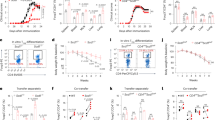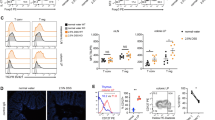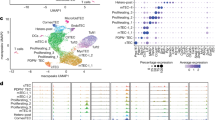Abstract
Thymic stromal cells, including cortical thymic epithelial cells (cTEC) produce many humoral factors, such as cytokines and eicosanoids to modulate thymocyte homeostasis, thereby regulating the peripheral immune responses. In this study, we identified fatty acid-binding protein (FABP4), an intracellular fatty acid chaperone, in the mouse thymus, and examined its role in the control of cytokine production in comparison with FABP5. By immunofluorescent staining, FABP4+ cells enclosing the thymocytes were scattered throughout the thymic cortex with a spatial difference from the FABP5+ cell that were distributed widely throughout the cTEC. The FABP4+ cells were immunopositive for MHC class II, NLDC145 and cytokeratin 8, and were identified as part of cTEC. The FABP4+ cells were identified as thymic nurse cells (TNC), a subpopulation of cTEC, by their active phagocytosis of apoptotic thymocytes. Furthermore, FABP4 expression was confirmed in the isolated TNC at the gene and protein levels. To explore the function of FABP in TNC, TSt-4/DLL1 cells stably expressing either FABP4 or FABP5 were established and the gene expressions of various cytokines were examined. The gene expression of interleukin (IL)-7 and IL-18 was increased both in FABP4 and FABP5 over-expressing cells compared with controls, and moreover, the increase in their expressions by adding of stearic acids was significantly enhanced in the FABP4 over-expressing cells. These data suggest that both FABPs are involved in the maintenance of T lymphocyte homeostasis through the modulation of cytokine production, which is possibly regulated by cellular fatty acid-mediated signaling in TEC, including TNC.




Similar content being viewed by others
References
Abdelwahab SA, Owada Y, Kitanaka N, Adida A, Sakagami H, Ono M, Watanabe M, Spener F, Kondo H (2007) Enhanced expression of adipocyte-type fatty acid binding protein in murine lymphocytes in response to dexamethasone treatment. Mol Cell Biochem 299:99–107
Anderson G, Lane PJ, Jenkinson EJ (2007) Generating intrathymic microenvironments to establish T-cell tolerance. Nat Rev Immunol 7:954–963
Anderson G, Moore NC, Owen JJ, Jenkinson EJ (1996) Cellular interactions in thymocyte development. Annu Rev Immunol 14:73–99
Antohe F, Popov D, Radulescu L, Simionescu N, Borchers T, Spener F, Simionescu M (1998) Heart microvessels and aortic endothelial cells express the 15 kDa heart-type fatty acid-binding proteins. Eur J Cell Biol 76:102–109
Augustin HG, Braun K, Telemenakis I, Modlich U, Kuhn W (1995) Ovarian angiogenesis. Phenotypic characterization of endothelial cells in a physiological model of blood vessel growth and regression. Am J Pathol 147:339–351
Brix S, Lund P, Kjaer TM, Straarup EM, Hellgren LI, Frokiaer H (2010) CD4(+) T-cell activation is differentially modulated by bacteria-primed dendritic cells, but is generally down-regulated by n-3 polyunsaturated fatty acids. Immunology 129:338–350
Cao WM, Murao K, Imachi H, Hiramine C, Abe H, Yu X, Dobashi H, Wong NC, Takahara J, Ishida T (2004) Phosphatidylserine receptor cooperates with high-density lipoprotein receptor in recognition of apoptotic cells by thymic nurse cells. J Mol Endocrinol 32:497–505
Chmurzynska A (2006) The multigene family of fatty acid-binding proteins (FABPs): function, structure and polymorphism. J Appl Genet 47:39–48
Chouaib S, Welte K, Mertelsmann R, Dupont B (1985) Prostaglandin E2 acts at two distinct pathways of T lymphocyte activation: inhibition of interleukin 2 production and down-regulation of transferrin receptor expression. J Immunol 135:1172–1179
Defresne MP, Nabarra B, van Vliet E, Willemsen R, van Dongen H, van Ewijk W (1994) The ER-TR4 monoclonal antibody recognizes murine thymic epithelial cells (type 1) and inhibits their capacity to interact with immature thymocytes: immuno-electron microscopic and functional studies. Histochemistry 101:355–363
El Kassar N, Lucas PJ, Klug DB, Zamisch M, Merchant M, Bare CV, Choudhury B, Sharrow SO, Richie E, Mackall CL, Gress RE (2004) A dose effect of IL-7 on thymocyte development. Blood 104:1419–1427
Ezaki T, Matsuno K, Kotani M (1991) Thymic nurse cells (TNC) in spontaneous thymoma BUF/Mna rats as a model to study their roles in T-cell development. Immunology 73:151–158
Gordon JI, Alpers DH, Ockner RK, Strauss AW (1983) The nucleotide sequence of rat liver fatty acid binding protein mRNA. J Biol Chem 258:3356–3363
Gorjao R, Azevedo-Martins AK, Rodrigues HG, Abdulkader F, Arcisio-Miranda M, Procopio J, Curi R (2009) Comparative effects of DHA and EPA on cell function. Pharmacol Ther 122:56–64
Guthmann F, Schachtrup C, Tolle A, Wissel H, Binas B, Kondo H, Owada Y, Spener F, Rustow B (2004) Phenotype of palmitic acid transport and of signalling in alveolar type II cells from E/H-FABP double-knockout mice: contribution of caveolin-1 and PPARgamma. Biochim Biophys Acta 1636:196–204
Guyden JC, Pezzano M (2003) Thymic nurse cells: a microenvironment for thymocyte development and selection. Int Rev Cytol 223:1–37
Hanhoff T, Lucke C, Spener F (2002) Insights into binding of fatty acids by fatty acid binding proteins. Mol Cell Biochem 239:45–54
Hare KJ, Jenkinson EJ, Anderson G (2000) An essential role for the IL-7 receptor during intrathymic expansion of the positively selected neonatal T cell repertoire. J Immunol 165:2410–2414
Hart G, Flaishon L, Shachar I (2007) IL-12 and IL-18 down-regulate B cell migration in an Ly49D-dependent manner. Eur J Immunol 37:1996–2007
Haunerland NH, Spener F (2004) Fatty acid-binding proteins–insights from genetic manipulations. Prog Lipid Res 43:328–349
Hunt CR, Ro JH, Dobson DE, Min HY, Spiegelman BM (1986) Adipocyte P2 gene: developmental expression and homology of 5’-flanking sequences among fat cell-specific genes. Proc Natl Acad Sci USA 83:3786–3790
Ito H, Esashi E, Akiyama T, Inoue J, Miyajima A (2006) IL-18 produced by thymic epithelial cells induces development of dendritic cells with CD11b in the fetal thymus. Int Immunol 18:1253–1263
Itoh T, Doi H, Chin S, Nishimura T, Kasahara S (1988) Establishment of mouse thymic nurse cell clones from a spontaneous BALB/c thymic tumor. Eur J Immunol 18:821–824
Kim K, Lee CK, Sayers TJ, Muegge K, Durum SK (1998) The trophic action of IL-7 on pro-T cells: inhibition of apoptosis of pro-T1, -T2, and -T3 cells correlates with Bcl-2 and Bax levels and is independent of Fas and p53 pathways. J Immunol 160:5735–5741
Kim KJ, Abrams J, Alphonso M, Pearce M, Thorbecke GJ, Palladino MA (1990) Role of endogenously produced interleukin-6 as a second signal in murine thymocyte proliferation induced by multiple cytokines: regulatory effects of transforming growth factor-beta. Cell Immunol 131:261–271
Kitanaka N, Owada Y, Abdelwahab SA, Iwasa H, Sakagami H, Watanabe M, Spener F, Kondo H (2003) Specific localization of epidermal-type fatty acid binding protein in dendritic cells of splenic white pulp. Histochem Cell Biol 120:465–473
Kitanaka N, Owada Y, Okuyama R, Sakagami H, Nourani MR, Aiba S, Furukawa H, Watanabe M, Ono M, Ohteki T, Kondo H (2006) Epidermal-type fatty acid binding protein as a negative regulator of IL-12 production in dendritic cells. Biochem Biophys Res Commun 345:459–466
Kurtz A, Zimmer A, Schnutgen F, Bruning G, Spener F, Muller T (1994) The expression pattern of a novel gene encoding brain-fatty acid binding protein correlates with neuronal and glial cell development. Development 120:2637–2649
Li Y, Pezzano M, Philp D, Reid V, Guyden J (1992) Thymic nurse cells exclusively bind and internalize CD4+ CD8+ thymocytes. Cell Immunol 140:495–506
Liu RZ, Li X, Godbout R (2008) A novel fatty acid-binding protein (FABP) gene resulting from tandem gene duplication in mammals: transcription in rat retina and testis. Genomics 92:436–445
Makowski L, Hotamisligil GS (2005) The role of fatty acid binding proteins in metabolic syndrome and atherosclerosis. Curr Opin Lipidol 16:543–548
Masouye I, Hagens G, Van Kuppevelt TH, Madsen P, Saurat JH, Veerkamp JH, Pepper MS, Siegenthaler G (1997) Endothelial cells of the human microvasculature express epidermal fatty acid-binding protein. Circ Res 81:297–303
Massa S, Balciunaite G, Ceredig R, Rolink AG (2006) Critical role for c-kit (CD117) in T cell lineage commitment and early thymocyte development in vitro. Eur J Immunol 36:526–532
McCormack JE, Kappler J, Marrack P, Westcott JY (1991) Production of prostaglandin E2 and prostacyclin by thymic nurse cells in culture. J Immunol 146:239–243
Miyazaki M, Kawamoto H, Kato Y, Itoi M, Miyazaki K, Masuda K, Tashiro S, Ishihara H, Igarashi K, Amagai T, Kanno R, Kanno M (2005) Polycomb group gene mel-18 regulates early T progenitor expansion by maintaining the expression of Hes-1, a target of the Notch pathway. J Immunol 174:2507–2516
Moore TA, von Freeden-Jeffry U, Murray R, Zlotnik A (1996) Inhibition of gamma delta T cell development and early thymocyte maturation in IL-7 −/− mice. J Immunol 157:2366–2373
Muller SM, Terszowski G, Blum C, Haller C, Anquez V, Kuschert S, Carmeliet P, Augustin HG, Rodewald HR (2005) Gene targeting of VEGF-A in thymus epithelium disrupts thymus blood vessel architecture. Proc Natl Acad Sci USA 102:10587–10592
Murphy EJ, Owada Y, Kitanaka N, Kondo H, Glatz JF (2005) Brain arachidonic acid incorporation is decreased in heart fatty acid binding protein gene-ablated mice. Biochemistry 44:6350–6360
Ogawa E, Owada Y, Ikawa S, Adachi Y, Egawa T, Nemoto K, Suzuki K, Hishinuma T, Kawashima H, Kondo H, Muto M, Aiba S, Okuyama R (2011) Epidermal FABP (FABP5) regulates keratinocyte differentiation by 13(S)-HODE-mediated activation of the NF-kappaB signaling pathway. J Invest Dermatol 131:604–612
Oida H, Namba T, Sugimoto Y, Ushikubi F, Ohishi H, Ichikawa A, Narumiya S (1995) In situ hybridization studies of prostacyclin receptor mRNA expression in various mouse organs. Br J Pharmacol 116:2828–2837
Owada Y, Suzuki R, Iwasa H, Spener F, Kondo H (2002a) Localization of epidermal-type fatty acid binding protein in the thymic epithelial cells of mice. Histochem Cell Biol 117:55–60
Owada Y, Takano H, Yamanaka H, Kobayashi H, Sugitani Y, Tomioka Y, Suzuki I, Suzuki R, Terui T, Mizugaki M, Tagami H, Noda T, Kondo H (2002b) Altered water barrier function in epidermal-type fatty acid binding protein-deficient mice. J Invest Dermatol 118:430–435
Owada Y, Yoshimoto T, Kondo H (1996) Spatio-temporally differential expression of genes for three members of fatty acid binding proteins in developing and mature rat brains. J Chem Neuroanat 12:113–122
Pezzano M, Philp D, Stephenson S, Li Y, Reid V, Maitta R, Guyden JC (1996) Positive selection by thymic nurse cells requires IL-1 beta and is associated with an increased Bcl-2 expression. Cell Immunol 169:174–184
Philp D, Pezzano M, Li Y, Omene C, Boto W, Guyden J (1993) The binding, internalization, and release of thymocytes by thymic nurse cells. Cell Immunol 148:301–315
Pompos LJ, Fritsche KL (2002) Antigen-driven murine CD4+ T lymphocyte proliferation and interleukin-2 production are diminished by dietary (n-3) polyunsaturated fatty acids. J Nutr 132:3293–3300
Rockett BD, Salameh M, Carraway K, Morrison K, Shaikh SR (2010) n-3 PUFA improves fatty acid composition, prevents palmitate-induced apoptosis, and differentially modifies B cell cytokine secretion in vitro and ex vivo. J Lipid Res 51:1284–1297
Sandal S, Tuneva J, Yilmaz B, Carpenter DO (2009) Effects of cholesterol and docosahexaenoic acid on cell viability and (Ca(2+))(i) levels in acutely isolated mouse thymocytes. Cell Biochem Funct 27:155–161
Schroeder F, Petrescu AD, Huang H, Atshaves BP, McIntosh AL, Martin GG, Hostetler HA, Vespa A, Landrock D, Landrock KK, Payne HR, Kier AB (2008) Role of fatty acid binding proteins and long chain fatty acids in modulating nuclear receptors and gene transcription. Lipids 43:1–17
Siegenthaler G, Hotz R, Chatellard-Gruaz D, Jaconi S, Saurat JH (1993) Characterization and expression of a novel human fatty acid-binding protein: the epidermal type (E-FABP). Biochem Biophys Res Commun 190:482–487
Simpson MA, LiCata VJ, Ribarik Coe N, Bernlohr DA (1999) Biochemical and biophysical analysis of the intracellular lipid binding proteins of adipocytes. Mol Cell Biochem 192:33–40
van Vliet E, Melis M, van Ewijk W (1984a) Immunohistology of thymic nurse cells. Cell Immunol 87:101–109
Van Vliet E, Melis M, Van Ewijk W (1984b) Monoclonal antibodies to stromal cell types of the mouse thymus. Eur J Immunol 14:524–529
von Freeden-Jeffry U, Solvason N, Howard M, Murray R (1997) The earliest T lineage-committed cells depend on IL-7 for Bcl-2 expression and normal cell cycle progression. Immunity 7:147–154
von Freeden-Jeffry U, Vieira P, Lucian LA, McNeil T, Burdach SE, Murray R (1995) Lymphopenia in interleukin (IL)-7 gene-deleted mice identifies IL-7 as a nonredundant cytokine. J Exp Med 181:1519–1526
Wall R, Ross RP, Fitzgerald GF, Stanton C (2010) Fatty acids from fish: the anti-inflammatory potential of long-chain omega-3 fatty acids. Nutr Rev 68:280–289
Watanabe M, Ono T, Kondo H (1991) Immunohistochemical studies on the localisation and ontogeny of heart fatty acid binding protein in the rat. J Anat 174:81–95
Wekerle H, Ketelsen UP (1980) Thymic nurse cells-Ia-bearing epithelium involved in T-lymphocyte differentiation? Nature 283:402–404
Wekerle H, Ketelsen UP, Ernst M (1980) Thymic nurse cells: lymphoepithelial cell complexes in murine thymuses: morphological and serological characterization. J Exp Med 151:925–944
Yamamoto N, Kaneko I, Motohashi K, Sakagami H, Adachi Y, Tokuda N, Sawada T, Furukawa H, Ueyama Y, Fukunaga K, Ono M, Kondo H, Owada Y (2008) Fatty acid-binding protein regulates LPS-induced TNF-alpha production in mast cells. Prostagland Leukot Essent Fatty Acids 79:21–26
Yu Q, Erman B, Bhandoola A, Sharrow SO, Singer A (2003) In vitro evidence that cytokine receptor signals are required for differentiation of double positive thymocytes into functionally mature CD8+ T cells. J Exp Med 197:475–487
Zubkova I, Mostowski H, Zaitseva M (2005) Up-regulation of IL-7, stromal-derived factor-1 alpha, thymus-expressed chemokine, and secondary lymphoid tissue chemokine gene expression in the stromal cells in response to thymocyte depletion: implication for thymus reconstitution. J Immunol 175:2321–2330
Acknowledgments
We cordially thank Dr. Willem V. Ewijk (Leiden University Medical Center, Leiden, The Netherlands) and Dr. Takashi Amagai for providing ER-TR4 antibody. We grateful thank to Dr. Hiroshi Kawamoto (RIKEN Research Center for Allergy and Immunology, Yokohama, Japan) for his useful comments and providing TSt-4 and TSt-4/DLL-1 cells, and Dr. Tsunetoshi Itoh (Tohoku University Graduate School of Medicine, Sendai, Japan) for providing IT-79MTNC cells. This work was supported by Grant-in-Aid for Young Scientists (B) to Y.A. (No. 19790152) from the Ministry of Education, Culture, Sports, Science and Technology (MEXT) of Japan, from the New Frontier Project Research Fund of Yamaguchi University Graduate School of Medicine to Y.A. and from the Yamaguchi University Research Project on STRESS.
Author information
Authors and Affiliations
Corresponding authors
Additional information
Y. Adachi and S. Hiramatsu contributed equally to this work.
Electronic supplementary material
Below is the link to the electronic supplementary material.
Rights and permissions
About this article
Cite this article
Adachi, Y., Hiramatsu, S., Tokuda, N. et al. Fatty acid-binding protein 4 (FABP4) and FABP5 modulate cytokine production in the mouse thymic epithelial cells. Histochem Cell Biol 138, 397–406 (2012). https://doi.org/10.1007/s00418-012-0963-y
Accepted:
Published:
Issue Date:
DOI: https://doi.org/10.1007/s00418-012-0963-y




